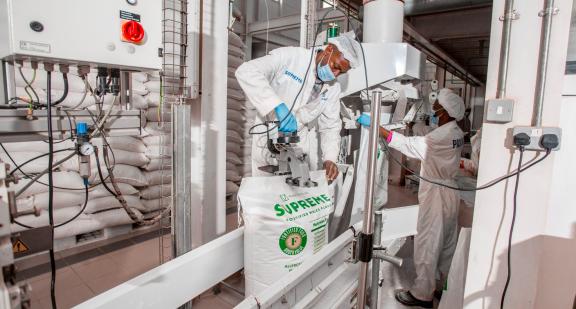Micronutrient deficiency, often known as “hidden hunger,” is the result of deficiencies in iron, zinc, vitamin A, vitamin B12, and folate, among others.
These deficiencies compromise immune systems, hinder child growth and development, and limit human capital. Accurate, consistent measurement of micronutrient deficiencies is critical to improving nutrition. For example, anemia is often misinterpreted as synonymous with iron deficiency, when in fact there are many causes of anemia including nutritional factors, diseases, parasites, and genetic traits. For decades, the accepted estimate of two billion people worldwide who experience micronutrient deficiency seemed to be based on the prevalence of anemia. USAID is helping improve measurement of both micronutrient deficiencies and anemia to help optimize efforts to improve nutrition.

Women of reproductive age and preschool aged children are at high risk of experiencing deficiency of at least one micronutrient, but the extent of micronutrient deficiencies among other population groups is not well understood.
Women of reproductive age and preschool aged children are at high risk of experiencing deficiency of at least one micronutrient, but the extent of micronutrient deficiencies among other population groups is not well understood.
For the last three decades, nutrition and global health practitioners and researchers have often stated that two billion people globally suffer from micronutrient deficiencies. However, the methods used to arrive at this number were not readily available, preventing researchers from updating the estimate.
USAID Advancing Nutrition collaborated with other institutions to estimate the current prevalence of micronutrient deficiencies worldwide. The study revealed that the prevalence of micronutrient deficiencies is high among women and preschool aged children. Unfortunately, the data required to estimate prevalence among other population groups is not available. This study not only gathered the available scarce information, but also shared the methodology so future researchers can assess progress on addressing micronutrient deficiencies.

Micronutrient Deficiencies among Preschool-Aged Children and Women of Reproductive Age Worldwide: A Pooled Analysis of Individual-Level Data from Population-Representative Surveys
For decades, the number of people with micronutrient deficiencies was believed to be two billion, without a clearly identifiable source. This paper provides an updated, more reliable estimate of global micronutrient deficiencies along with a detailed methodology so other researchers can replicate the results and periodically update these estimates. The paper also highlights the lack of data on micronutrient deficiencies among other population groups, for example school-aged children and men.

Hidden No More: New Estimates Help the Nutrition Community Support Women and Children at Risk of Micronutrient Deficiencies
Read about how USAID Advancing Nutrition, the Global Alliance for Improved Nutrition and the Micronutrient Deficiencies Research Group, convened by the Micronutrient Forum, approached the challenge of assessing global micronutrient deficiencies to ensure that future researchers are able to reliably track progress in reducing “hidden hunger.”

Coffee and Chai Chats: Spotlighting Hidden Hunger
Between November 2022 and March 2023, the Micronutrient Forum hosted a series of online conversations to discuss the implications of the revised global estimates of micronutrient deficiencies.

New Global Estimates of Micronutrient Deficiencies
This panel discussion hosted by GAIN and the Micronutrient Forum unpacked some of the findings from the new analysis of the global estimate and implications for programs around the world.

Consuming fortified staple foods and micronutrient supplements may protect against micronutrient deficiencies; to program more effectively, we must measure nutrient intake.
Implementation research and innovative approaches to data analysis and modeling are contributing to what we know about current levels of micronutrient consumption and what proportion of the population is at risk of inadequate vitamin and mineral intake.
Consuming fortified staple foods and micronutrient supplements may protect against micronutrient deficiencies; to program more effectively, we must measure nutrient intake.
Implementation research and innovative approaches to data analysis and modeling are contributing to what we know about current levels of micronutrient consumption and what proportion of the population is at risk of inadequate vitamin and mineral intake.

Comparing Costs and Cost-Efficiency of Platforms for Micronutrient Powder (MNP) Delivery to Children in Rural Uganda
This pilot study compares the cost and cost-efficiency of MNP distribution to households either through community-based platforms or through health facilities in the rural Namutumba district in Uganda (pop. 220,000). The study assessed both direct costs for the distribution and opportunity costs of the program (i.e. the cost of reallocating time and resources from other programs), The cost of MNP distribution over 9 months in Namutumba (including the opportunity costs of village health teams, health workers, and caregivers’ time) was USD $277,082 for the community platform and USD $221,568 for the facility platform. The MNP distribution cost per child was USD $53.24 with community distribution and USD $65.97 for facility-based distribution.
A similar MNP distribution program in Bangladesh that reached 5.4 million children 6-59 months old, cost USD $14.6 million or USD $2.7 per child. The relatively high costs of MNP distribution in Uganda is a factor in implementing this intervention. The study also led to the development of a technical brief on costing studies for micronutrient interventions, which highlights how a cost-efficiency study can influence policy decisions.

Improving Diets Through Innovative Data Analysis and Modeling of Food Fortification in Malawi
This event shared innovative approaches to inform policies and programs in Malawi that can address the underlying risk factors of micronutrient inadequacies. USAID Advancing Nutrition collaborated with the London School of Hygiene and Tropical Medicine and the Micronutrient Action Policy Support (MAPS) Project to use household consumption and expenditure survey data to estimate the prevalence of inadequate apparent micronutrient intake and the potential contribution of large-scale food fortification to micronutrient adequacy. For example, in Malawi, modeling the contribution of vitamin A fortified vegetable oil and sugar to vitamin A adequacy demonstrated that the addition of vitamin A into vegetable oil and sugar can contribute to a reduction in the proportion of people with inadequate vitamin A intake.

USAID created a task force of global experts to review emerging anemia-related evidence.
USAID created a task force of global experts to review emerging anemia-related evidence.
The USAID Advancing Nutrition Anemia Task Force is composed of a diverse group of experts from around the world representing academic research centers like University of California at Davis, University of Melbourne, Columbia University, Federal Institute of Technology (ETH Zurich), Emory University and Kenya Medical Research Institute, grant-making foundations like the Gates Foundation, U.S. government agencies like NIH and CDC, and international agencies like the International Atomic Energy Agency. The group brings the most recent findings in anemia research and understanding to USAID and its partners. This multi-disciplinary panel of experts from around the world, provides valuable insights into the biology and assessment of anemia, as well as the public health and nutrition interventions to address anemia.

Anemia Toolkit
Access more than 130 anemia-related resources identified by the Anemia Task Force to help public health practitioners understand anemia and the relevant actions to reduce it.

Anemia Briefs
Informed by the work of the Anemia Task Force, USAID Advancing Nutrition produced five briefs that explore current evidence and practice to understand and address the causes and consequences of anemia.

Anemia Task Force Supplement
These four papers together outline the new ecological approach to reducing anemia. Understanding the ecology of anemia—the biology of nutrients interacting with physical, economic, social, behavioral, demographic, and environmental factors—is key to implementing context-specific interventions to reduce anemia.

Exploring the Anemia Ecology: A New Approach to an Old Problem
The U.S. Government Global Nutrition Coordination Plan hosted an event to share the USAID Advancing Nutrition Anemia Task Force’s integrated approach, which covers key aspects of anemia biology, assessment, and translation into interventions.

Improving hemoglobin measurement contributes to more accurate and precise estimates of anemia prevalence.
Improving hemoglobin measurement contributes to more accurate and precise estimates of anemia prevalence.
Clinicians assess anemia by measuring hemoglobin (Hb) concentration in blood. However, Hb measurements can vary depending on the device as well as the nature of the blood sample (either a sample taken from a vein or a capillary) and the skills of the technicians. USAID Advancing Nutrition is helping public health researchers understand how Hb measurement can be improved to obtain more accurate and precise population-based anemia estimates and better assess the results of anemia interventions.

HEmoglobin MEasurement (HEME) Laboratory Protocol for Measurement of Hemoglobin in Population Surveys
The HEmoglobin MEasurement (HEME) working group, a multi-institutional research collaborative that brings together researchers and experienced practitioners working on Hb measurement in different countries and institutions, developed this protocol to assess the accuracy and precision of three point-of-care Hb measurement devices and three types of blood samples (venous, pools of capillary blood, and single drops of capillary blood).

USAID Advancing Nutrition Awards HEmoglobin MEasurement Study Grants to Five Organizations
USAID Advancing Nutrition issued grants to five organizations around the world to carry out research designed to better understand Hb measurement across different devices and contexts.

Comparing Methods and HemoCue Devices to Determine Hemoglobin in Population-Based Surveys
Preliminary results from the HEME study suggest that blood drawn from veins (venous blood) and analyzed on a HemoCue model Hb 201+ provides the most reliable hemoglobin measurement, and that using samples of capillary blood to measure hemoglobin levels should be discontinued. With statistical adjustment, other HemoCue models (Hb 301 and Hb 801) can provide satisfactory results when venous blood is used. A second phase of this study is ongoing to try to find how to collect and process pools of capillary blood to compare hemoglobin levels with those obtained with venous blood.
